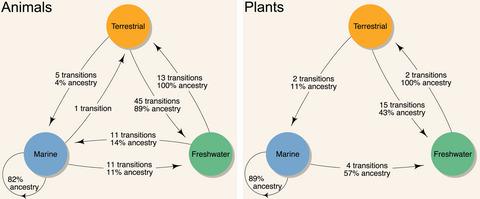当前位置:
X-MOL 学术
›
Ecol. Lett.
›
论文详情
Our official English website, www.x-mol.net, welcomes your
feedback! (Note: you will need to create a separate account there.)
The origins of global biodiversity on land, sea and freshwater
Ecology Letters ( IF 7.6 ) Pub Date : 2022-03-25 , DOI: 10.1111/ele.13999 Cristian Román-Palacios 1 , Daniela Moraga-López 2 , John J Wiens 1
Ecology Letters ( IF 7.6 ) Pub Date : 2022-03-25 , DOI: 10.1111/ele.13999 Cristian Román-Palacios 1 , Daniela Moraga-López 2 , John J Wiens 1
Affiliation

|
Many biodiversity studies focus on explaining high tropical species richness, but an equally dramatic yet understudied pattern involves the divergent richness of land, sea and freshwater. Here, we reveal the origins of these richness differences among habitats across animals and plants. Most plant and animal species are terrestrial, although these habitats cover only ~28% of Earth's surface. Marine habitats have fewer species over a larger area (~70%). Freshwater habitats have relatively high richness and exceptional phylogenetic diversity given their tiny area (2%). The relative richness of habitats is related to variation in diversification rates. Based on ancestral reconstructions of habitat, we find that most marine species are descended from marine ancestors and most terrestrial species from freshwater ancestors. Yet, most extant animal richness in freshwater is derived from terrestrial ancestors. Overall, our results reveal the origins of fundamental but neglected biodiversity patterns, and highlight the conservation importance of freshwater habitats.
中文翻译:

全球陆地、海洋和淡水生物多样性的起源
许多生物多样性研究侧重于解释热带物种的高度丰富性,但同样引人注目但未被充分研究的模式涉及陆地、海洋和淡水的不同丰富度。在这里,我们揭示了动植物栖息地之间这些丰富性差异的起源。大多数植物和动物物种都是陆生的,尽管这些栖息地仅覆盖地球表面的约 28%。海洋栖息地在较大区域内的物种较少(约 70%)。淡水栖息地由于面积小(2%)而具有相对较高的丰富度和特殊的系统发育多样性。栖息地的相对丰富程度与多样化率的变化有关。基于对栖息地的祖先重建,我们发现大多数海洋物种是海洋祖先的后代,而大多数陆生物种是淡水祖先的后代。然而,大多数现存的淡水动物丰富性来自陆地祖先。总体而言,我们的结果揭示了基本但被忽视的生物多样性模式的起源,并强调了淡水栖息地保护的重要性。
更新日期:2022-03-25
中文翻译:

全球陆地、海洋和淡水生物多样性的起源
许多生物多样性研究侧重于解释热带物种的高度丰富性,但同样引人注目但未被充分研究的模式涉及陆地、海洋和淡水的不同丰富度。在这里,我们揭示了动植物栖息地之间这些丰富性差异的起源。大多数植物和动物物种都是陆生的,尽管这些栖息地仅覆盖地球表面的约 28%。海洋栖息地在较大区域内的物种较少(约 70%)。淡水栖息地由于面积小(2%)而具有相对较高的丰富度和特殊的系统发育多样性。栖息地的相对丰富程度与多样化率的变化有关。基于对栖息地的祖先重建,我们发现大多数海洋物种是海洋祖先的后代,而大多数陆生物种是淡水祖先的后代。然而,大多数现存的淡水动物丰富性来自陆地祖先。总体而言,我们的结果揭示了基本但被忽视的生物多样性模式的起源,并强调了淡水栖息地保护的重要性。











































 京公网安备 11010802027423号
京公网安备 11010802027423号